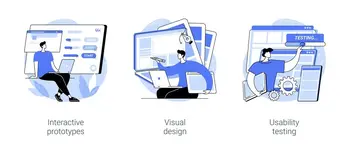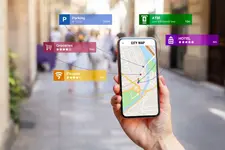
Table of contents
Welcome to our guide on 16 ways to make your website more interesting and keep people coming back. In today’s world, it’s not enough to just get people to visit your website. You also need to keep them engaged and make them want to buy from you. This guide will show you how to do just that and improve the website conversion of prospective clients.
There are many websites, so it is important to make yours stand out and be memorable. We will learn about different ways to engage users, such as creating interesting content, making the website easy to use, and adding interactive elements. By doing these things, you can connect with your audience, get them involved, and encourage them to come back.
In this guide, you will learn how to make your website better. You can do this by writing interesting content, making it easy to find things on your website, having a fast load time, and making sure that your website looks good on phones and computers. You can also add features like live chat, user-generated content, and email marketing.
If you use these 16 strategies and keep track of how well your website is doing, you will be able to get more people to visit your website and keep them coming back. Let’s get started and learn how to create a website that will make your business successful.
What is website engagement?
This is about how much people like and use a website. It shows people’s interest in the website’s content, features, and design. Websites with high user engagement have people who spend a lot of time on the site and do things like sign up for newsletters or buy products. The use of website engagement tools like surveys, e.t.c. is one of the actionable strategies to boost website content.
Website user engagement can be measured by how long people stay on a website, how many pages they visit, how often they come back, how many times they click on links, and how much they interact with things like comments, likes, shares, and submissions.
When people spend a lot of time on your website, it means they like it. They might read your articles, watch your videos, or even buy something from you. This is called user engagement, and it’s important for businesses because it can lead to more customers and more revenue. With higher user engagement, your website will perform better in google analytics by showing up in the top search results.
There are a few things you can do to increase online user interaction. One is to make sure your website is easy to use and navigate. Another is to create content that is interesting and relevant to your target audience. You can also offer incentives for people to engage with your website, such as discounts or free gifts.
By increasing online customer engagement, you can improve customer satisfaction, increase sales, and build brand loyalty.
How do you engage people on a website?

To keep people interested in a website, you need to think carefully about what you write and how you present it. First, you need to get their attention right away. You can do this by using catchy headlines and clear messages that tell people what your website is about. You can also use interesting pictures and videos to make your website more visually appealing. If you make a good first impression, people are more likely to keep reading and exploring your website.
Once you have their attention, it is important to boost engagement by adding engaging content which makes clear calls to action that encourage people to participate. Adding interactive features like quizzes, surveys, or calculators makes your content more fun and engaging. Well-placed and prominent calls to action guide people to do things like buy something or sign up for a newsletter. These prompts should be clear, easy to understand, and interesting, which will make people more likely to do what you want them to do.
Personalizing a website can make people more interested in it. You can do this by changing the website to fit what people like, what they have looked at before, and who they are. This can be done by giving people personalized recommendations, suggesting content, or offering products. When people feel like the website knows what they want and gives them what they want, they are more likely to stay on the website and look around thus increasing website navigation time. Using all of these strategies together can make the website more interesting and interactive.
What is the best way to increase engagement on the website?
There is no easy way to get people to use your website. It depends on who you are trying to reach, what kind of business you have, and what you want people to do on your website. But here are some things you can try.
Strategies to Enhance Website Engagement
Here are 16 effective strategies to increase online user interaction and retain customers:
1. Add live chat for real-time assistance:

Long wait times to get answers frustrate website users. Live chat offers a convenient engagement strategy for customers to seek assistance while browsing your website. Instead of waiting for email responses or being put on hold during phone calls, customers can engage in live conversations and get their questions or concerns addressed promptly.
2. Automate website engagement with AI bots:
AI bots use artificial intelligence to interact with people who visit your site. Here’s how it works: When someone lands on your website, the AI bot pops up and greets them. It can ask questions, provide information, and even offer recommendations. The bot is designed to understand what people are looking for and give helpful responses in a conversational way.
For example, let’s say you have an online store selling shoes. When a visitor comes to your website, the AI bot can ask them about their shoe preferences and suggest the perfect pair based on their answers. It can also answer common questions like sizing, availability, and shipping options.
One of the best things about AI bots is that they’re available 24/7, so visitors can get assistance even outside of business hours. They can provide instant support, helping people find what they need and making their experience on your website more enjoyable.
3. Use personalized email campaigns:
Personalized content attracts customers and leads to higher open rates, click rates, and the rate of conversion.
When customers sign up for your newsletter or interact with your website, you gather valuable information about them. This can include their preferences, purchase history, and browsing behaviour. By leveraging this data, you can create email campaigns that speak directly to their interests and needs which can increase user engagement.
You can also use personalized emails to show appreciation for your customers. For instance, you can send birthday emails with special discounts or rewards that make them feel celebrated. By acknowledging important milestones or events in their lives, you foster a stronger connection and loyalty.
The beauty of personalized email campaigns is that they create a sense of connection and relevance. Instead of sending generic emails to everyone, you’re tailoring each message to suit the unique preferences of your customers. This personalized touch demonstrates that you value them as individuals, leading to increased engagement and customer satisfaction.
4. Run social media ads:

Social media ads are an effective way to engage customers and generate leads. For example, let’s say you run a fitness studio and want to attract more people to join your classes. With online community ads, you can create an engaging ad showcasing the benefits of your workouts, the fun atmosphere in your studio, and any special promotions you have. You can then target the ad to appear to people in your local area who have shown an interest in fitness or similar activities. These ads help put your studio in front of the right audience at the right time, thus a good digital marketing strategy.
5. Publish blog posts regularly:
By maintaining a regular blogging schedule, you can keep your audience engaged and coming back for more. Whether once a week, twice a month, or any other frequency that suits your business, the key is to be consistent. Each blog post offers an opportunity to connect with your readers, establish yourself as an industry expert, and showcase your unique perspective.
The beauty of regular blog posts is that they keep your website fresh, attracting search engine traffic and encouraging repeat visits. When people find your blog posts helpful and engaging, they’re more likely to explore other parts of your website and potentially become customers.
6. Use a ‘reach-to-loyalty’ framework:
This is like building a ladder of trust and connection with your customers, starting from the very first interaction and leading all the way to long-term loyalty. It’s a strategic approach that focuses on nurturing relationships and turning prospective clients into loyal advocates of your brand.
The ‘reach’ stage involves reaching out to a wider audience, capturing their attention, and introducing them to your brand. This can be done through various marketing channels such as influencer Partnerships, advertising, or content marketing.
Once you’ve reached prospective clients, the ’engage’ stage comes into play. This is where you provide valuable and relevant content, personalized experiences, and exceptional customer service to keep them engaged.
The ‘convert’ stage is when you encourage prospective clients to take action and make a purchase or engage with your services. It could be through enticing offers, limited-time promotions, or personalized recommendations.
Finally, the ’loyalty’ stage focuses on building strong, lasting relationships with your customers. You provide ongoing value, rewards, and exclusive perks to encourage repeat business and advocacy. By delivering exceptional experiences and going the extra mile, you turn customers into loyal fans who not only continue to support your brand but also enthusiastically recommend you to others.
7. Optimize campaigns with high-impact video content:
Videos have a unique power to tell stories, showcase products or services, and evoke emotions. By creating high-impact videos, you can grab the viewer’s attention and leave a lasting impression. These videos can be used across various marketing channels, such as online Communities, websites, or email campaigns.
8. Conduct A/B testing to understand customer preferences:

A/B testing allows you to create multiple variations of a webpage, email, ad, or any other marketing asset. These variations, let’s call them A and B, are identical except for one specific element that you want to test. It could be the headline, colour scheme, button placement, or even the wording of a call-to-action.
For example, let’s say you’re a tech company launching a new website. With A/B testing, you can create two versions of your homepage. Version A has a blue colour scheme with a prominent Buy Now button, while version B has a green colour scheme with a Learn More button at the top. By directing half of your web visitors to version A and the other half to version B, you can gather data and analyze which version leads to more conversions or engagement.
The beauty of A/B testing is that it helps you make data-driven decisions. By measuring the performance of each variation, you can determine which elements resonate better with your audience and drive the desired actions. This allows you to optimize your marketing assets and make informed choices based on real user preferences.
9. Encourage customers to leave reviews:
Customer reviews are powerful social proof that can influence the buying decisions of others. You can measure user satisfaction by encouraging your customers to leave reviews. You’re giving them a platform to express their satisfaction and share their positive experiences with your products or services.
Positive customer feedback has a ripple effect. When potential customers see a stream of glowing reviews, it builds trust and confidence in your brand. They feel more comfortable making a purchase or choosing your services because they see that others have had positive experiences. It’s like having a virtual word-of-mouth marketing campaign that works 24/7.
While positive reviews can boost your reputation, negative reviews play a crucial role in identifying areas of improvement and driving growth.
When customers leave negative reviews, it may initially seem disheartening. However, these reviews provide valuable insights into areas where your business can enhance its products, services, or customer experiences. Embrace negative reviews as opportunities to listen to your customers, understand their concerns, and take necessary actions to address them.
10. Offer discount codes and promotions:
Discount codes and promotions are special offers that provide customers with a price reduction or additional value when they make a purchase. These can be in the form of percentage-based discounts, buy-one-get-one-free offers, free shipping, or even gift with purchase.
When implementing this strategy, it’s important to set clear objectives and determine the impact on your profitability. You want to strike a balance between offering attractive deals and maintaining a healthy profit margin. It’s also beneficial to track the performance of different discount codes and promotions to understand what resonates best with your customers.
11. Use pop-up forms to gather customer information:
This is a strategy that involves displaying a form in a pop-up window on your website to collect valuable customer data, such as email addresses, names, or preferences.
Pop-up forms are effective because they capture the attention of your website visitors and encourage them to take action. They provide a convenient and non-intrusive way to gather customer information, allowing you to build a database of potential leads or engage with existing customers more effectively.
When implementing pop-up forms, it’s important to strike a balance between capturing customer information and respecting their user experience. Avoid overwhelming visitors with excessive pop-ups or intrusive designs that hinder their browsing. Instead, ensure that your pop-up forms are visually appealing, offer clear value, and can be easily dismissed if the visitor prefers not to provide their information.
12. Optimize SEO:

Optimizing SEO involves fine-tuning your website to make it more visible and attractive to search engines like Google.SEO stands for Search Engine Optimization, and it uses various techniques to improve the appearance and positioning of your web pages in organic search results. By implementing effective SEO strategies, you can increase the quality and quantity of traffic to your website.
To optimize your SEO effectively, it’s important to stay up to date with current SEO trends and best practices. Resources like Moz, HubSpot, and Backlinko offer valuable insights and guidance.
13. Use responsive design:
Using responsive design means designing and building your website in a way that automatically adjusts and looks good on different devices, such as desktop computers, tablets, and smartphones. It ensures that your website is easily accessible and user-friendly, regardless of the screen size or resolution. A web design that is mobile responsive can increase audience engagement. Another important aspect to consider is the website load speed. Your site should be able to load fast to provide an experience encouraging for returning visitors.
By using responsive design, you ensure that your website delivers a consistent and user-friendly experience across all devices. This strategy is crucial in today’s mobile-driven world, as more and more users access the internet using smartphones and tablets. By catering to their needs, you can improve engagement, increase the rate of conversion, and enhance overall customer satisfaction.
14. Enhance website speed:
Enhancing website speed is a strategy that focuses on optimizing the loading time and performance of your website. It involves various techniques to ensure that your web pages load quickly and efficiently, providing a seamless and satisfying experience for visitors.
Here’s why it’s important: When a website takes too long to load, it can frustrate visitors and lead to higher bounce rates. People expect websites to load swiftly, and if they experience delays, they may abandon the site altogether and seek alternatives. By enhancing your website speed, you can capture and retain the attention of your audience, providing a positive user experience.
15. Engage in social listening:
Engaging in social listening is a strategy that involves actively monitoring and analyzing online conversations related to your brand and industry. It provides valuable insights into what people are saying about your company, products, or services on social media platforms.
By engaging in social listening you can better identify and address customer issues and concerns. For example, if customers frequently mention a specific problem or provide feedback about a particular aspect of your product, you can use this information to improve your offerings and address their needs.
16. Offer easy checkout:
A smooth checkout process ensures customers return and convert more frequently. Customers expect a hassle-free and efficient checkout experience when making purchases online. The checkout process should be straightforward and simple to navigate, with minimal steps required to complete the purchase.
To achieve an easy checkout experience, businesses should choose a trusted payment gateway that accepts all major payment methods and has a secure and reliable payment system. This will help to build trust with customers and ensure that their sensitive information is protected.
In addition, businesses should make sure the checkout page is mobile-friendly so that customers can easily make purchases from their mobile devices. The checkout page should also be optimized for speed and offer a guest checkout option for those who do not want to create an account.
How to measure website engagement

Measuring online user interaction is crucial to understanding how effectively your website captures and retains your visitors’ attention. So, having a website engagement checker is important. Here are some key metrics and methods to measure website engagement rate:
(a) Time on Page
This metric measures the average time visitors spend on each page of your website. Longer average session duration generally indicates higher engagement. To improve time on the page, you must know how to keep users on your website and how to increase website traffic as well as online user interaction rate. The answer to all those lies in increasing meaningful interactivity.
(b) Bounce Rate
The bounce rate represents the percentage of visitors who leave your website after viewing only one page. A lower bounce rate usually indicates better engagement, as visitors are exploring multiple pages.
(c) Page Views
Page views indicate the number of times a page on your website has been viewed. Higher page views suggest increased engagement as visitors are actively navigating through your content.
(d) Click-Through Rate (CTR)
CTR measures the percentage of visitors who click on a specific link or call to action on your website. Higher CTRs demonstrate that visitors are actively engaging with your content.
(e) Conversion Rate
The conversion rate measures the percentage of visitors who complete a desired action, such as making a purchase or filling out a form. Higher conversion rates suggest strong engagement and effective website design.
(f) Social Shares and Comments
Monitoring the number of social media shares and comments on your content can indicate how engaged your audience is, as they actively interact and share your content with others.
(g) Heatmaps
Heatmaps visually represent user activity on your website, indicating where visitors are clicking, scrolling, and spending the most time. Heatmaps provide valuable insights into user behaviour and engagement.
(h) User Surveys and Feedback
Conducting surveys or collecting feedback from visitors allows you to directly understand their level of engagement and satisfaction with your website.
(i) A/B Testing

By comparing different versions of your website or specific elements, you can measure which variations lead to higher interaction metrics.
(j) Website Analytics Tools
Utilize website data analysis tools like Google Analytics to track and analyse various user engagement metrics, providing detailed insights into user behaviour.
Why is website engagement important?
Website engagement is of paramount importance for several reasons:
1. Retaining attention
In the vast and competitive digital landscape, capturing and retaining the attention of website visitors is essential. High website engagement indicates that users are actively interacting with your content, exploring multiple pages, and spending more time on your site. This prolonged engagement increases the chances of them absorbing your message, understanding your offerings, and potentially converting into customers.
2. Building trust and credibility

Engaging website experiences help build trust and credibility with your audience. When visitors find your website valuable, informative, and user-friendly, they are more likely to perceive your brand positively. Positive experiences and interactions can lead to a stronger sense of trust, increasing the likelihood of repeat visits, conversions, and recommendations to others.
3. Increasing conversions and sales
Engaged visitors are more likely to convert into customers or take desired actions. By keeping visitors interested, guiding them through the conversion funnel, and providing clear calls to action, you can boost the rate of conversion and drive sales. Higher online user interaction signifies that your website is effectively capturing the attention, interest, and intent of visitors, leading to a higher likelihood of achieving your business goals.
4. Improving search engine rankings
Search engines consider user engagement signals as an indicator of a website’s quality and relevance. Websites with higher interaction metrics tend to perform better in search engine rankings. When users spend more time on your website, view multiple pages, and interact with your content, search engines perceive it as a positive signal of relevance and quality, potentially leading to higher organic traffic and visibility.
5. Fostering brand loyalty and advocacy
Engaged visitors are more likely to develop a connection with your brand and become loyal customers. When your website provides a valuable and engaging experience, visitors are more likely to remember your brand, return for future interactions, and become advocates who share positive experiences with others. This word-of-mouth promotion can lead to an increased customer base and brand growth.
Conclusion
In conclusion, the implementation of effective strategies to increase online user interaction is a fundamental aspect of driving online success and retaining valuable customers. By adopting the 16 strategies discussed in this guide, businesses can create a compelling and interactive online presence that captures the attention of visitors and encourages their active participation.
Through the development of captivating content, clear navigation, and personalised experiences, businesses can forge stronger connections with their audience. The integration of social proof, gamification elements, and responsive design further enhances engagement and fosters a sense of trust and loyalty. Leveraging the power of instant chat support, user-generated content, and strategic email marketing and online communities integration amplifies the impact of these strategies, ultimately driving conversions and customer retention.
Embracing these strategies to increase website engagement empowers businesses to thrive in the competitive digital landscape. By continuously monitoring and adapting these approaches, businesses can meet the evolving needs and expectations of their audience, establishing a strong and enduring online presence.
In essence, by implementing the strategies outlined in this guide, businesses can elevate their online user interaction to new heights, create lasting connections with their customers, and pave the way for sustained growth and success in the digital realm.
















